8 Must-see UNESCO World Heritage Sites in Vietnam
Ready to visit the 8 UNESCO Vietnam World Heritage Sites? Read our guide for details on the most essential info and how to get to each one.
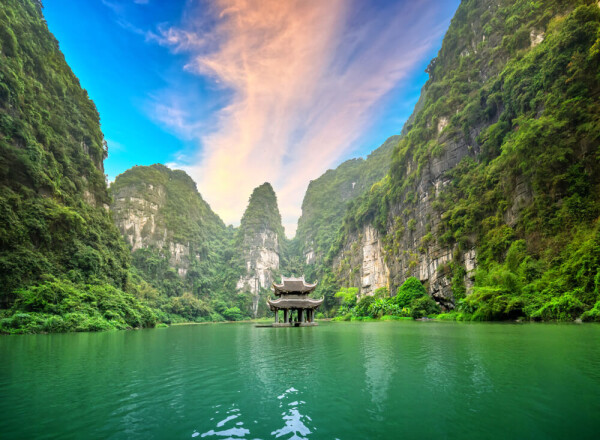
If you are wondering how many UNESCO World Heritage Sites exist in Vietnam, you have come to the right place. This diverse country is brimming with rich history, captivating natural beauty, and eight incredible treasures recognized by UNESCO.
Let’s delve into the wonders of these internationally acclaimed sites, each with its own fascinating tale to tell.
UNESCO World Heritage Cultural Sites in Vietnam
1. Citadel of the Ho Dynasty (recognized by UNESCO in 2011)
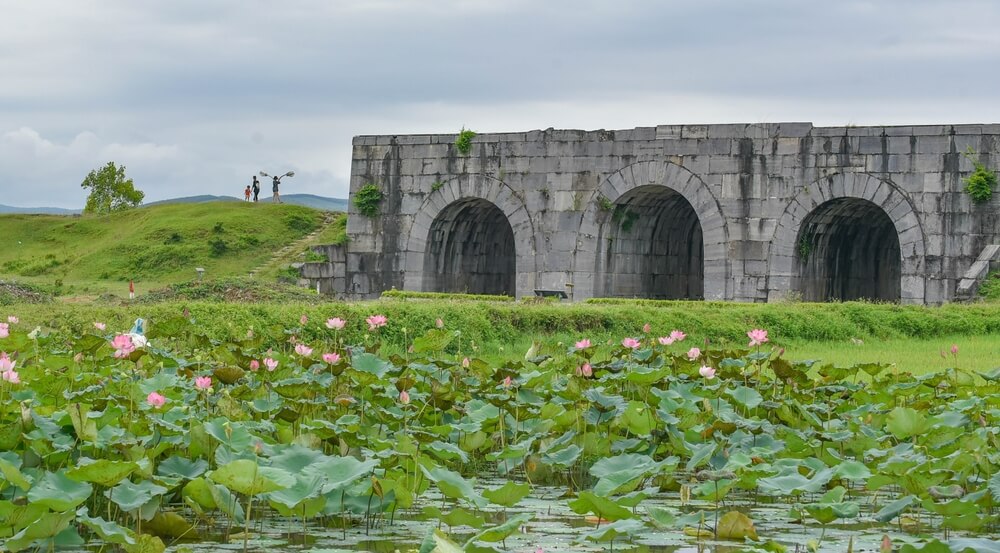
Sites like Ha Long Bay and Hoi An often steal the spotlight for the UNESCO World Heritage sites in Vietnam. However, there’s a hidden gem that deserves your attention – the Citadel of the Ho Dynasty. It’s a historical site with a rich history, stunning architecture and a tranquil setting.
It was constructed in 1397 under the supervision of Ho Quy Ly, who was the very first monarch of the dynasty and forcibly took the throne. The Citadel of Ho served as the capital of Vietnam from 1400 to 1407.
So, what makes this world heritage site so UNESCO-worthy?
It features one of the most unique stone architectures in Vietnam and the world. They built it without using any mortar, lifting and stacking 10 to 26 tons of limestone from the ground up to ten meters! What’s more impressive is that it was built in just three months and still stands 600 years later.
How to explore the site:
Even though this site gained UNESCO recognition in 2011, the Citadel of Ho Dynasty remains relatively undiscovered by tourists.
It is best to spend the night before your visit at one of two nearby cities, Ninh Binh or Thanh Hóa City.
When morning comes, and you arrive at the site, enter through the south gate, where you’ll find a small museum and helpful information boards. Sometimes, a guide is available.
Take your time to wander or cycle through the vast complex and explore the acres of rice fields and lotus ponds. The pathways are still the exact layout of the original city’s streets.
How to get to the Citadel of the Ho Dynasty:
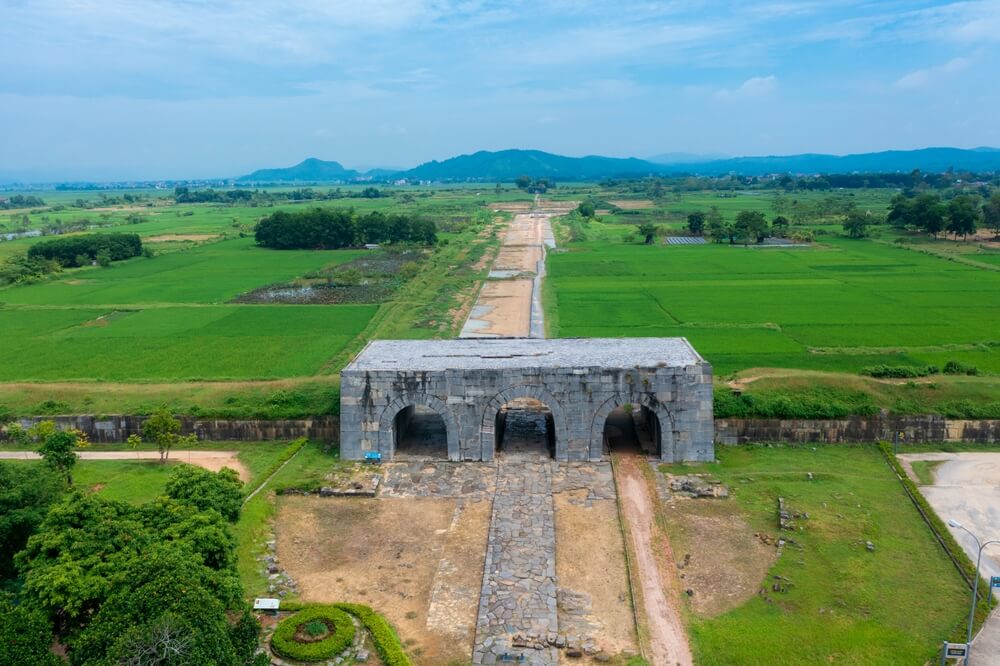
This World Heritage UNESCO Vietnam site is in the Vinh Loc District in the Thanh Hoa Province.
Tucked away in the picturesque landscape between the Ma and Buoi rivers, the Citadel of the Ho Dynasty occupies a prime location. It is approximately 62 km (38.5 miles) from Ninh Binh and 45 km (28 miles) from Thanh Hóa City.
If you are traveling from Hanoi to Ninh Binh, it will take you 1-2 hours in either a minivan or bus.
If you are traveling from Hanoi to Thanh Hoa, it will take you three hours on a VIP bus or by train with Vietnam Railways.
While these options won’t take you to the site directly, you can take a taxi from either location to get you the rest of the way.
2. The Complex of Monuments of Huê (recognized in 1993)
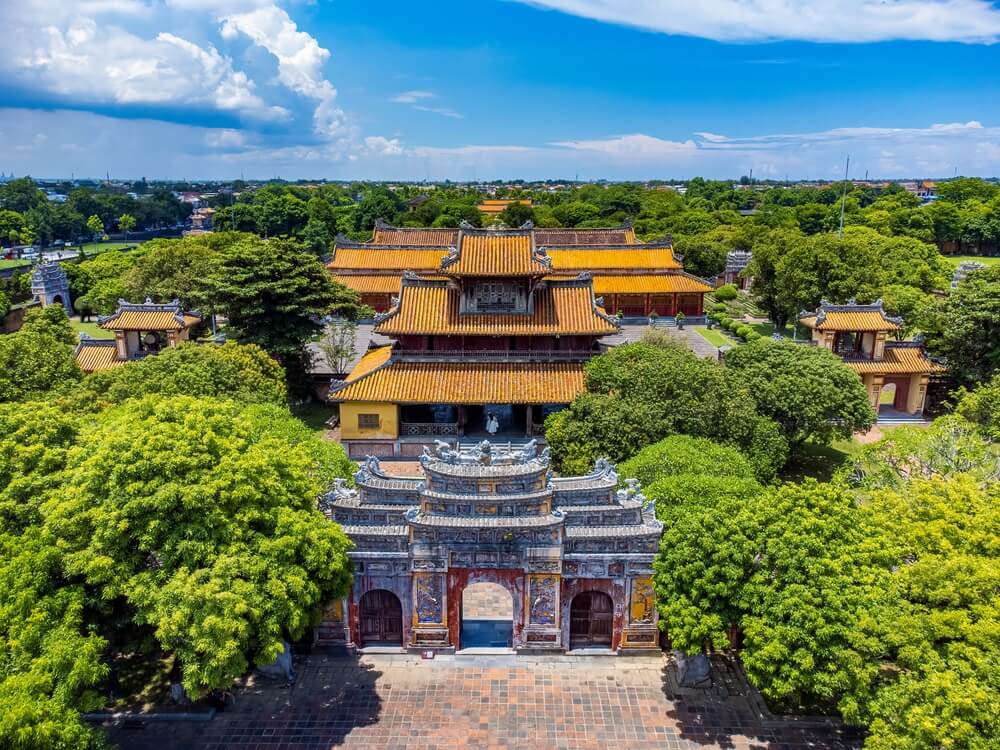
If you enjoy escaping the hustle and bustle, Huê is a perfect oasis.
The extensive complex showcases numerous historic and cultural treasures. From the Forbidden Purple City to several royal tombs and temples, you will get a glimpse into Vietnam’s fascinating past and architectural marvels.
This walled fortress served as the capital of the Nguyen Dynasty, the last feudal dynasty in Vietnam, from 1802 to 1945.
When construction of the Hue Historic Citadel began in 1803, it took nearly 30 years to finish this massive complex.
During the Vietnam War, Huê, unfortunately, endured significant damage as it became a target of bombs and artillery fire, with many architectural structures damaged.
Today, you can see the reconstruction undertaken to restore the site to its previous glory.
Want to know something else that’s interesting? The Nguyen Dynasty was the last royal dynasty in Vietnamese history.
How to explore the site:
This UNESCO site in Vietnam is best explored by starting at the Huê Citadel, the central structure that once housed the administrative and military functions of the Nguyen Dynasty.
Then, visit the Imperial City and the Forbidden Purple City, which offers insights into the daily lives of the royal family.
Pay attention to the details as you admire the meticulously designed gardens, ornate palaces and beautifully decorated pavilions.
Pro tip: Venture beyond the citadel to the royal tombs and temples along the Perfume River; they delve deeper into the fascinating history of the area.
How to get to the Complex of Monuments of Huê:
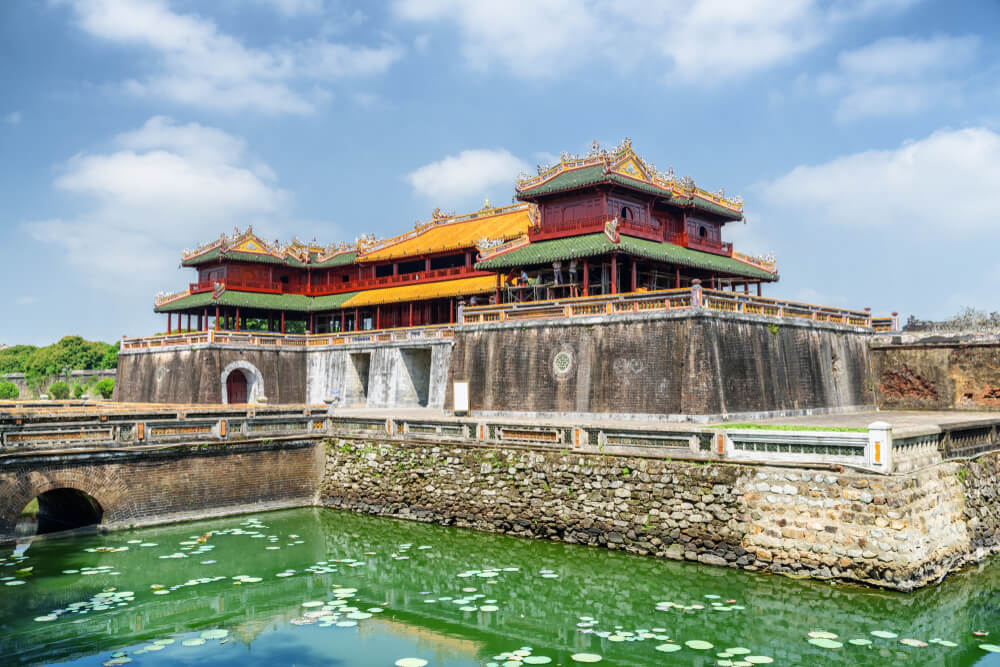
This UNESCO World Heritage Site in Vietnam is located in and around the city of Huê, which once served as the cultural, educational, political and economic center of Thua Thien Huê Province.
From the capital city of Hanoi to Hue, you can take a leisurely flight with VietJet Air or Vietnam Airlines, which only takes 1 hour and 15 minutes. Otherwise, there are long-haul buses that take between 11 and 13 hours.
3. Mi-sön Shrine (recognized in 1999)
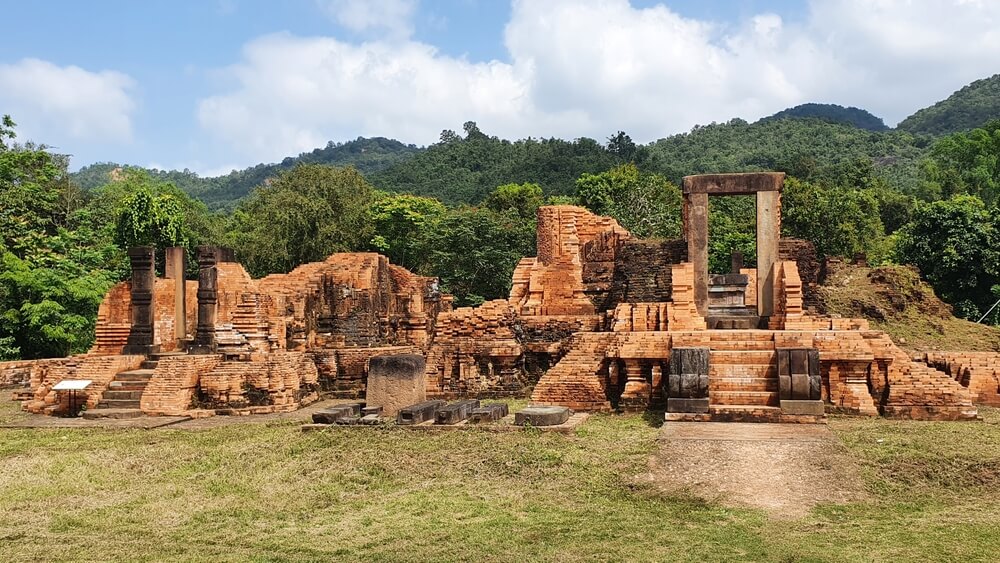
The Mi-sön Shrine (also known as My Son Sanctuary) is an ancient temple complex built between the 4th and 13th centuries by the Champa people. The main temple was constructed over a span of 900 years. Its beauty will amaze you.
Conflicts with neighboring empires and the expansion of the nearby Dai Viet people led to the abandonment of the site in the 13th century.
It wasn’t until 1898 that French archaeologists rediscovered the site after it had been swallowed by jungle.
Today, the Mi-sön Shrine is recognized as one of the most captivating archaeological sites in Southeast Asia. It stands as a testament to the rich cultural and religious history of the Champa Kingdom.
How to explore the site:
If you wish to go with a guide, you can either depart from Hoi An or Da Nang, both nearby. A tour will provide transportation and knowledgeable guides who will give you a deeper understanding of the site’s history and significance.
Don’t miss the Champa dance performance; it will further enrich your understanding of culture.
Pro tip: Wear comfortable shoes. On arrival, you will traverse the sanctuary on foot, walking through the various temple groups and admiring the intricate brickwork and sandstone reliefs.
How to get to the My Son Sanctuary:
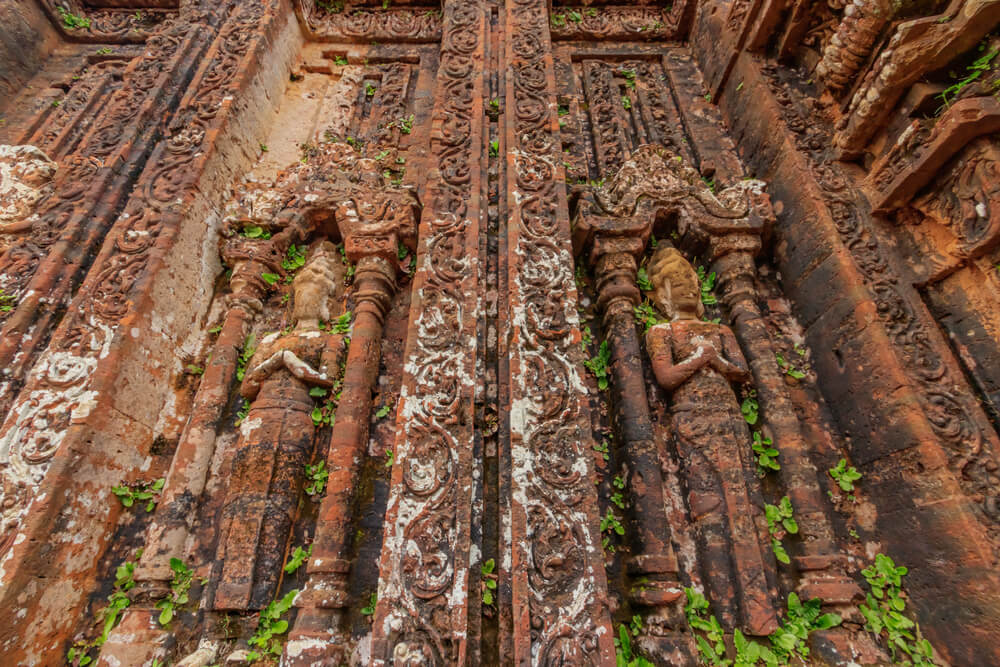
Imagine a picturesque valley surrounded by lush greenery and overlooked by the imposing Cat’s Tooth Mountain (Hon Quap). Welcome to The Mi-sön Shrine.
Located in central Vietnam, close to Hoi An, you can easily reach this UNESCO site by car or van from Da Nang or Hoi An to My Son. The ride takes about 1 hour and 15 minutes.
4. Central Sector of the Imperial City of Thang Long (recognized in 2010)
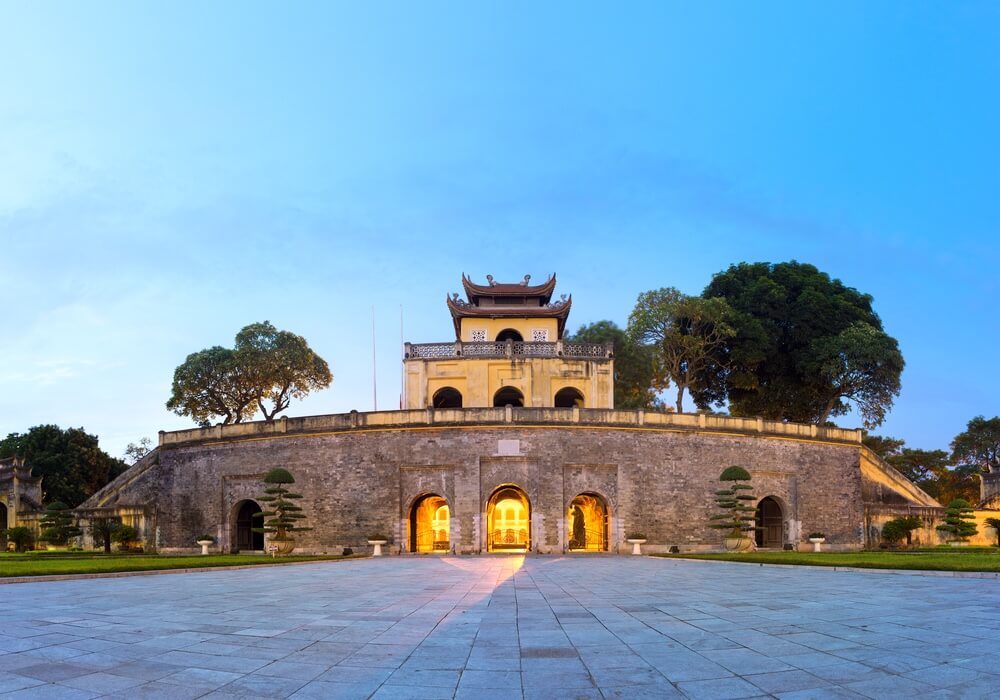
The Imperial City of Thang Long was originally constructed in the 11th century during the Ly Dynasty. Since then, the citadel has witnessed the rise and fall of different dynasties, including the Ly, Tran, and Le Dynasties.
Fun fact: The citadel’s name, Thang Long, translates to “ascending dragon” and symbolizes the strength and resilience of the Vietnamese people.
How to explore the site:
Let’s see what you can expect from a day at this UNESCO World Heritage site in Vietnam.
Explore ancient palaces, temples, bunkers and peaceful surroundings, reflecting varying architectural styles, on a self-guided tour or with a guide.
While you may not find any original buildings from the 11th century, you will see that many destroyed buildings have been rebuilt. Or that the remains are still preserved.
One of the most interesting buildings is a small building at the back of the site called D67. It was used by the Vietnamese government during the Vietnam War.
Today, you can head underground to the bunker room nine meters beneath the surface.
How to get to the Imperial City of Thang Long:
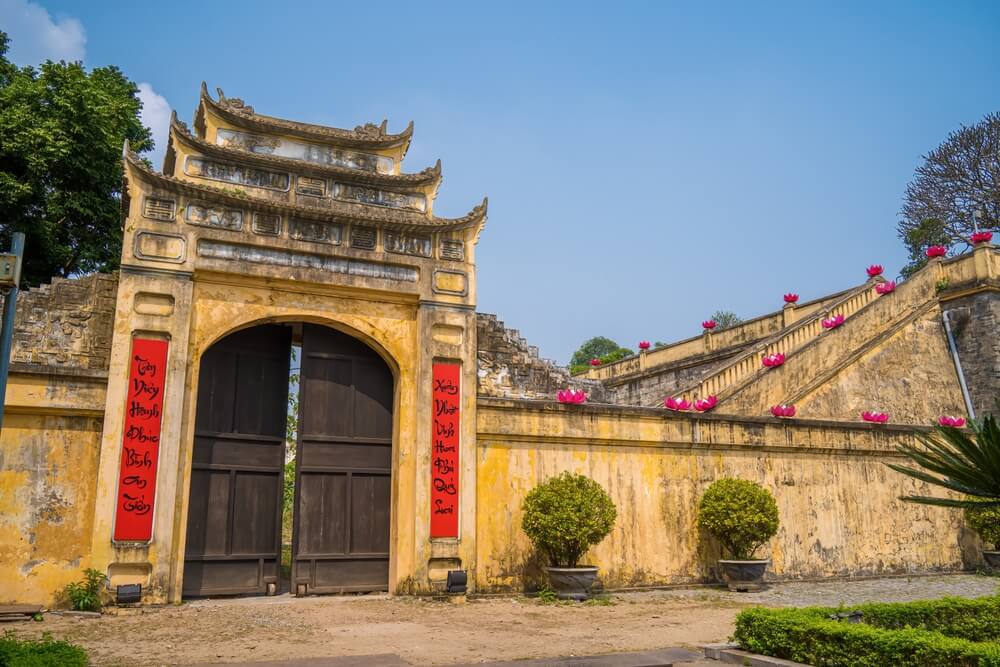
With a convenient position at the center of Hanoi, the Imperial City of Thang Long is surrounded by other popular attractions, including the Temple of Literature and the Vietnam Military History Museum.
Depending on where you are coming from, below are some options for reaching this UNESCO site in Hanoi.
To get to Hanoi from Ho Chi Minh City, take a 2-hour and 10-minute flight. You can take a sleeper train with Vietnam Railways, but it takes over 24 hours.
From Da Nang to Hanoi, the flight time is 1 hour and 20 minutes, or if you prefer slow travel, a bus will take you 11-13 hours.
Finally, from Ninh Binh to Hanoi, you can travel in the comforts of a luxury minivan or VIP bus. This route will take you 1 hour and 20 minutes.
5. Hoi An Old Town (recognized in 1999)
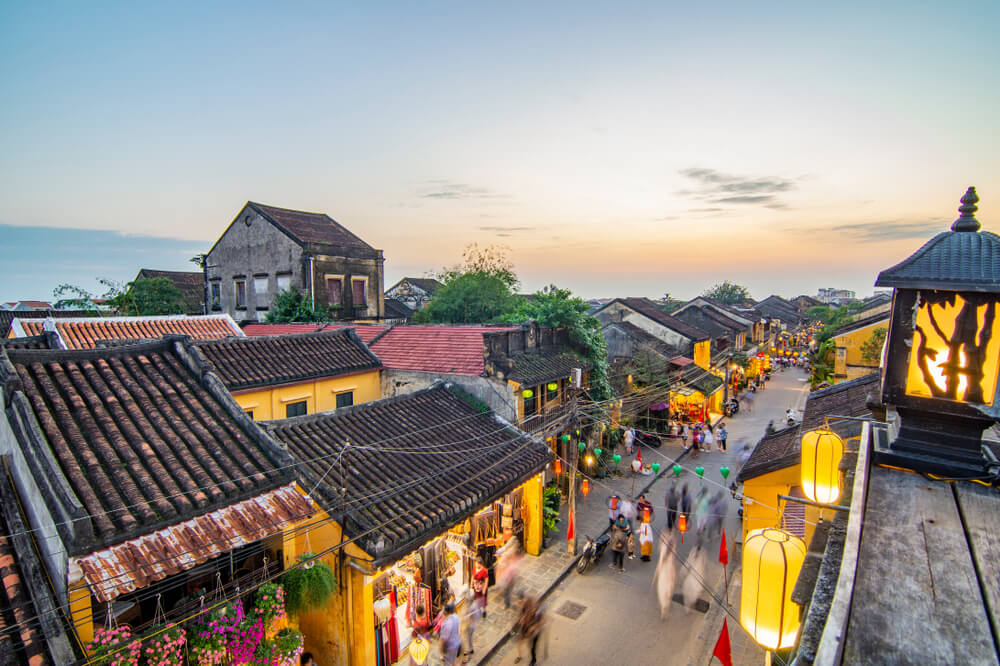
Hoi An is a popular town that attracts tourists from all around the world. However, few know about its history, which dates back to the 15th century.
Situated in the Quang Nam Province in Central Vietnam, the city lies on the north bank near the mouth of the Thu Bon River. Due to its location near the coast, it was a vital Southeast Asian trading port between the 15th and 19th centuries, particularly with China, Japan, and India.
Being a prominent trading port means the town’s architectural style and cultural influences reflect this diverse mix of cultures.
And since the nearby town of Da Nang became the modern trading port, Hoi An maintained its traditional character and layout, which is why it’s such an important site.
Fun fact: Did you know the name Hoi An translates to “peaceful meeting place?”
How to explore the site:
Get lost. We mean it. There are many narrow streets to explore where you can find beautifully preserved buildings that showcase a fusion of foreign architectural styles.
Some cultural monuments do, however, require an entrance fee. These include the Quan Cong Temple, Cau Bridge, Church of the Tran family and Phung Hung Ancient House.
Pro tip: As a tourist, purchasing an entrance ticket will allow you access to 5 of the 22 sightseeing attractions.
Also, stay for three days in Hoi An. You don’t want to miss places like the bustling Central Market, where you can experience the local culture and sample the local dishes.
How to get to the Hoi An Vietnam UNESCO site:
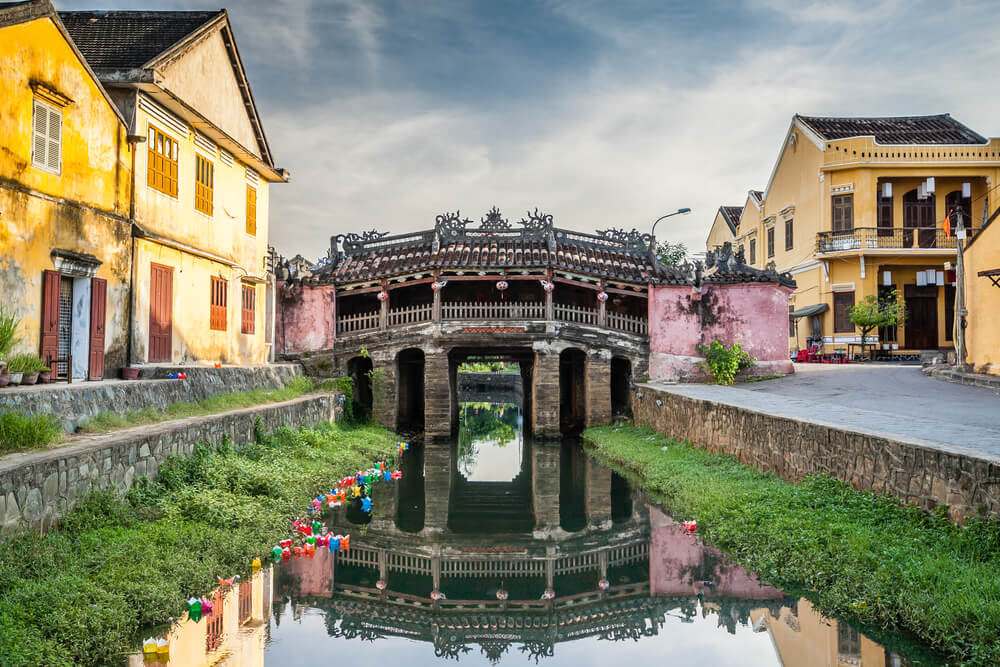
From Hanoi to Hoi An, it will take you 15 hours and 30 minutes on a sleeping bus by The Long Travel.
Otherwise, you can fly to Da Nang from Hanoi, which takes 1 hour and 20 minutes. On arrival, jump in a minivan, taxi, or bus from Da Nang International Airport to Hoi An, 28.5km (17.7 miles) away.
UNESCO World Heritage Natural Sites in Vietnam
6. Ha Long Bay (recognized in 1994 and 2000)
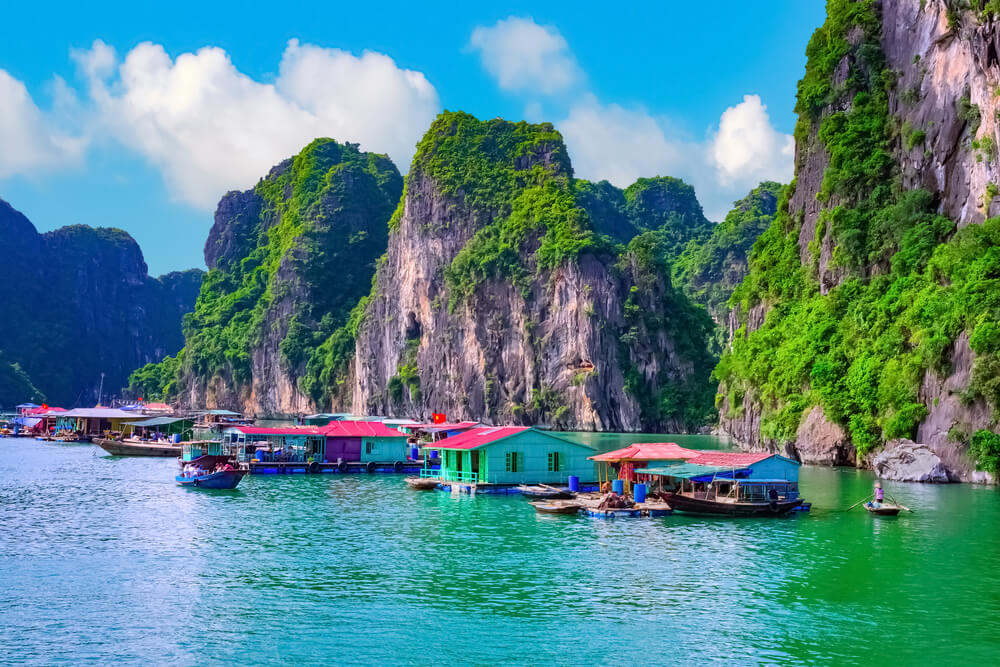
If you are dreaming of visiting a breathtaking UNESCO site, then Ha Long Bay (also spelled Halong Bay) is your answer. Picture emerald waters and towering limestone karsts – it is not only mystical but also serene.
Get ready to travel back in time. Because Ha Long Bay dates back millions of years, when the movement of tectonic plates gave rise to its unique landscape. There are some 1,600 limestone islands and islets – an awe-inspiring panorama.
Legend has it that a dragon was defending the Vietnamese from invasion by using fire, emeralds and jade. The jewels landed in the ocean and formed limestone karsts, which stopped invaders from coming any further.
Whether you believe it or not, the bay has been an integral part of Vietnamese culture and history.
It also served as a strategic naval base during times of conflict and was a significant trading hub during the region’s maritime trade era.
Fun fact: Ha Long Bay was first listed as a UNESCO World Heritage Site in 1994, recognizing its outstanding, universal aesthetic value. In 2000, it was recognized for a second time for its incredible geological and geomorphological value.
How to explore the site:
Throughout your research, it is more than likely you have come across photos on board a cruise to Ha Long Bay. It’s the best way to see Ha Long Bay as it allows you to explore the area while enjoying panoramic views.
You can choose between a Halong Bay cruise that lasts for a couple of hours or one that lasts for a couple of days. Some even include the opportunity to kayak and snorkel.
Otherwise, if you are light on time and flush with cash, a great way to see Ha Long Bay in all of its glory is on a seaplane tour.
How to get to Ha Long Bay:
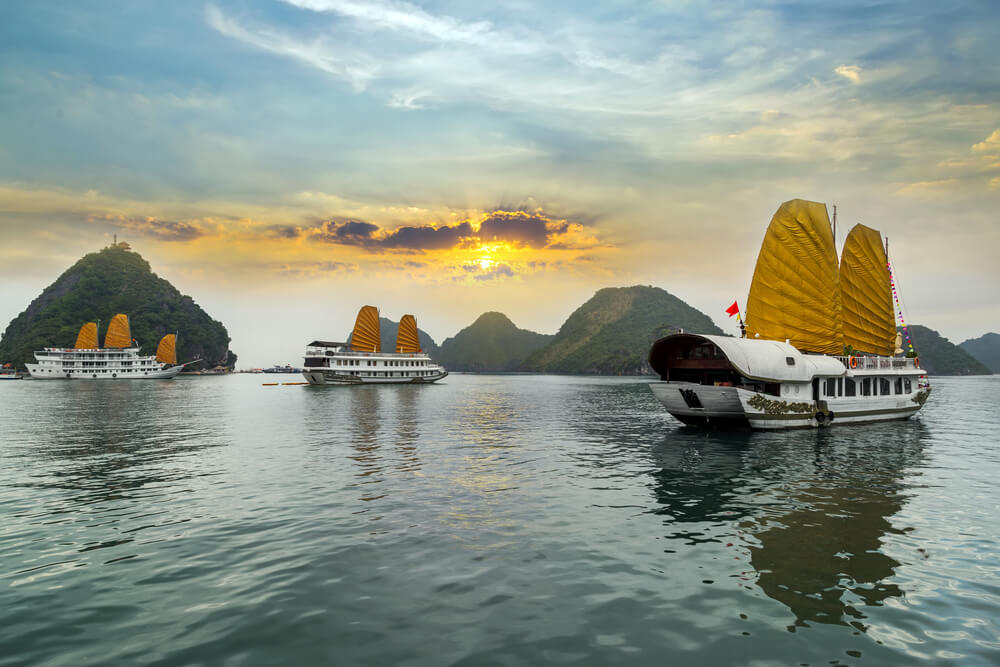
Situated in the Quang Ninh Province, this area is approximately 170 km (105 miles) east of Hanoi.
Its strategic location along the Gulf of Tonkin makes it easily accessible by various means of transport. From Hanoi to Ha Long Bay, it will take you two hours by luxury minivan or car. Otherwise, a bus will take you an extra 30 minutes.
7. Phong Nha-Ke Bang National Park (recognized in 2003 and 2015)
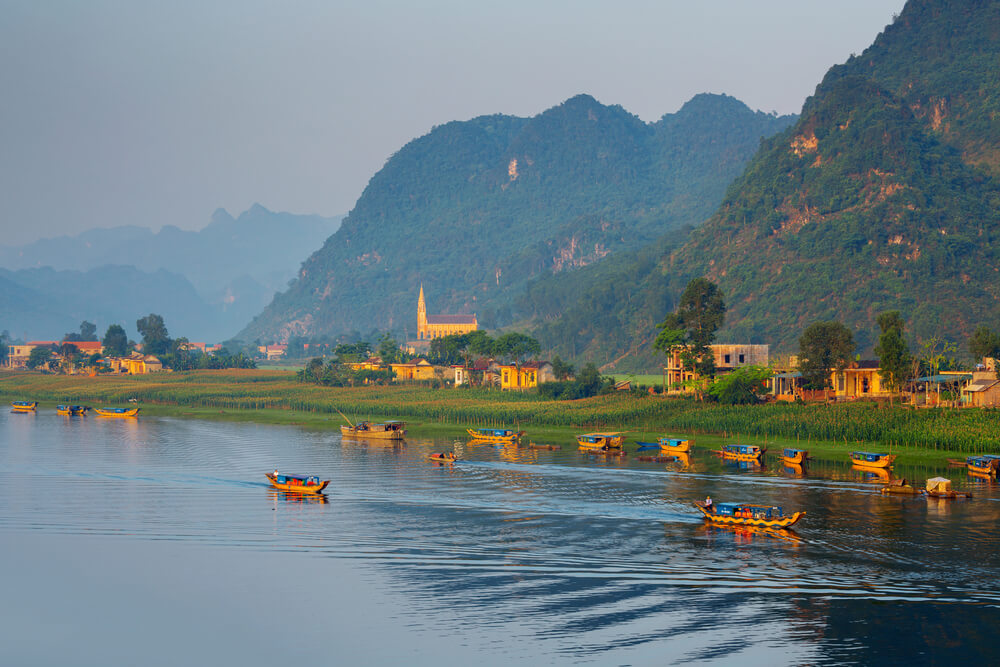
Between the stunning karst landscapes, underground rivers, and immense cave systems, these pristine sights will leave you in awe.
This site was recognized by UNESCO for its geomorphological criteria in 2003 and again in 2015 for its biodiversity and ecological criteria.
It was millions of years ago that the karst formations were sculpted through the dynamic forces of tectonic movement and erosion. The cave systems that resulted served as the base for the Vietnamese army during the Vietnam War and provided refuge for local communities.
How to explore the site:
You can choose between a cave tour, which delves into the mesmerizing underground world and stops at Son Doong Cave, the largest known cave passage in the world.
Otherwise, you can trek through the jungle. Yes, you will need your hiking boots, but this is an incredible way to immerse yourself in the park’s diverse flora and fauna.
For those who prefer a slower pace, take a leisurely river cruise along the Son River. You’ll not only be able to take in the stunning scenery, but you will also be able to spot wildlife and appreciate the tranquility around you.
How to get to Phong Nha-Ke Bang National Park:
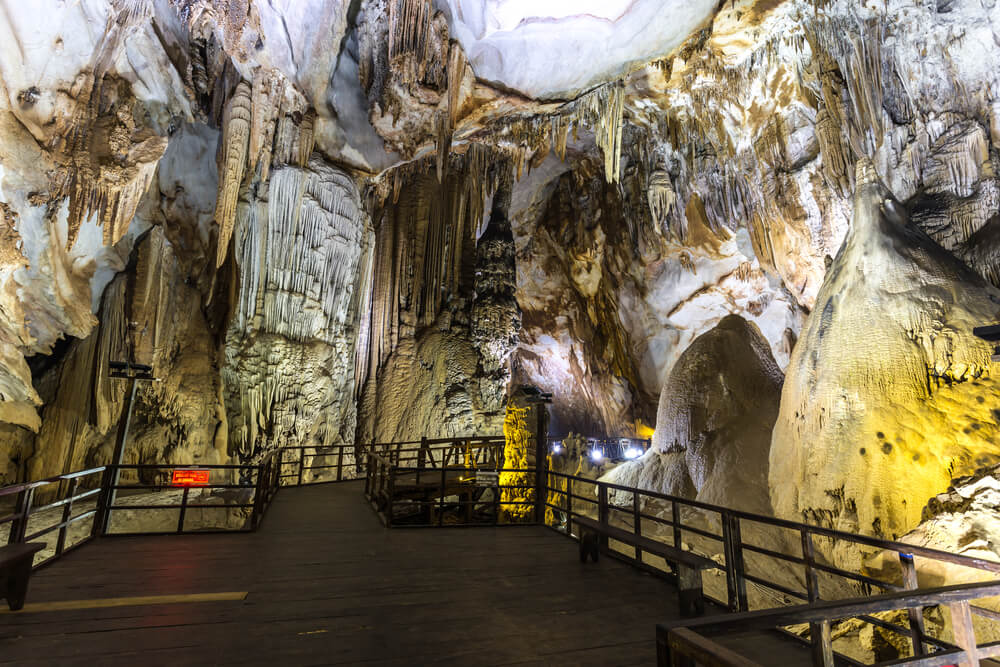
Phong Nha-Ke Bang National Park is in Central Vietnam in the Quang Binh province.
The best location to base yourself is the city of Dong Hoi, 50 km (31 miles) away.
From Hoi An to Dong Hoi, it will take you nearly six hours by car or minivan. Or if you are coming from Hue to Dong Hoi, it will only take you three hours on a train or three hours in a car.
Vietnam’s UNESCO World Heritage Mixed (cultural and natural) Site
8. Trang An Landscape Complex (recognized in 2014)
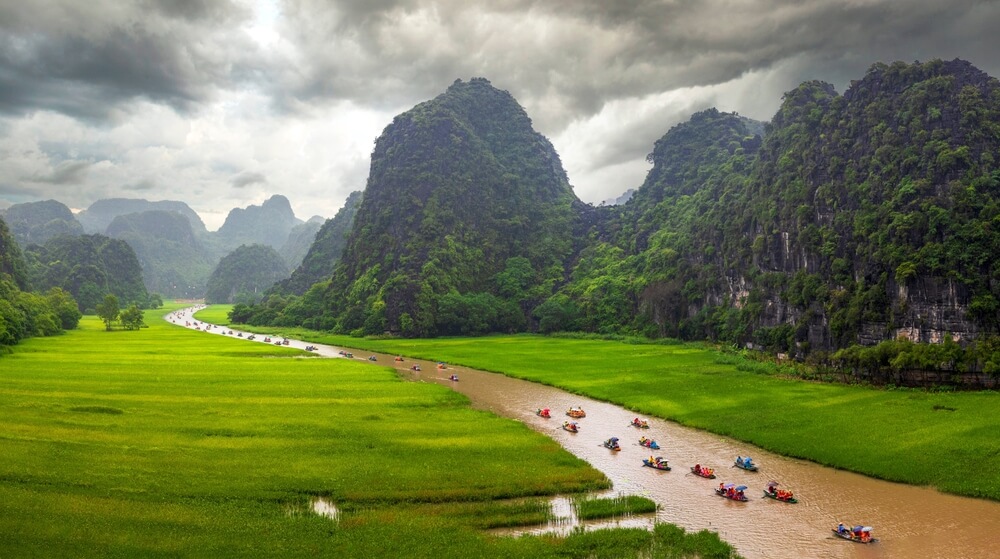
Last but not least is the Trang An Landscape Complex, which mesmerizes visitors with its stunning blend of natural beauty and historical significance.
Wondering why this site has been recognized as both a cultural and natural UNESCO Site?
It’s because its rich cultural history dates back thousands of years. Traces of ancient settlements, burial sites and relics found in the region suggest a long history of human activity. Over time, the inhabitants witnessed and adapted to dramatic climatic and environmental changes.
Additionally, of the Vietnam World Heritage Sites, this one is renowned for its spectacular karst landscapes, limestone mountains, valleys, and caves, as well as an intricate system of rivers, rice paddies, and villages.
Today, you will find an array of cone-shaped rocks with vertical walls rising abruptly 200 meters above sea level.
Fun fact: The water levels continue to change from season to season, which creates many unique ecosystems and landscapes.
How to explore the site:
If this sounds up your alley, take a boat tour along the meandering waterways, giving you an incredible view of the limestone karsts, lush greenery and hidden caves.
Be sure to find a tour that includes visiting Hang Mua Peak and the enchanting Tam Coc caves.
Hang Mua Peak is a steep climb of 500 steps. It may seem daunting at first, but the views over the valley, limestone mountains, and rice terraces are rewarding.
You can stay in the area. Otherwise, if you are short on time, some tours depart from Hanoi.
For the more adventurous, rent a bicycle to explore the countryside, and you’ll pass through quaint villages and rice fields.
How to get to the Trang An Landscape Complex:
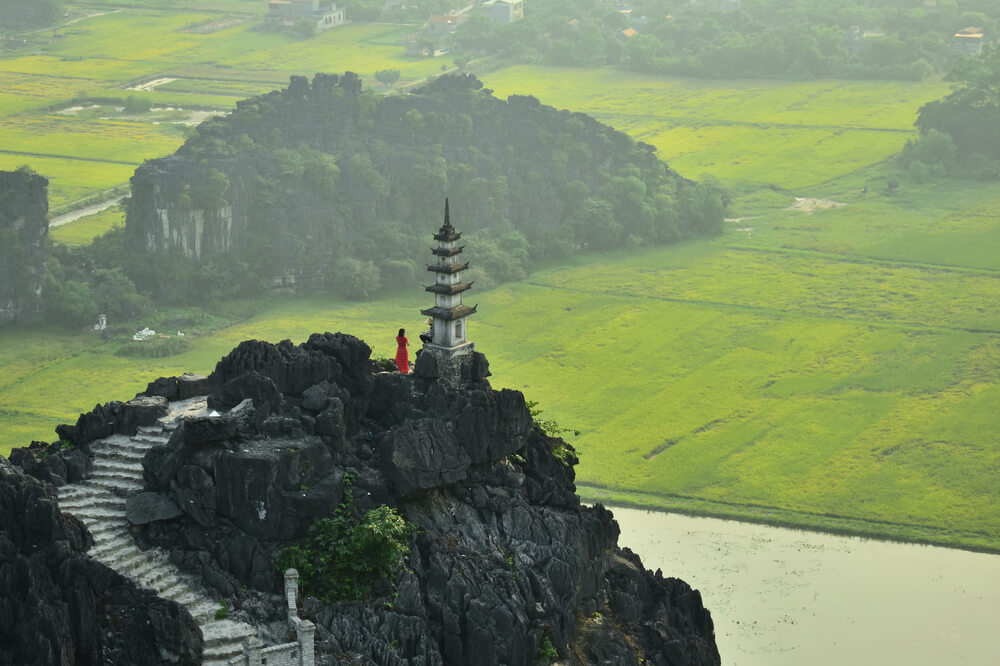
Trang An Landscape Complex is located in the Ninh Binh Province of northern Vietnam.
To get to Ninh Binh from Hanoi, you must travel 100km (62 miles) south of the city in a VIP Minivan. This will take you two hours and 30 minutes.
Map of the 8 UNESCO Heritage Sites in Vietnam
Ready to go UNESCO site hopping? This map will show you how close they are to one another. This is a helpful way to plan your trip throughout Vietnam.
It’s time to book your trip to Vietnam
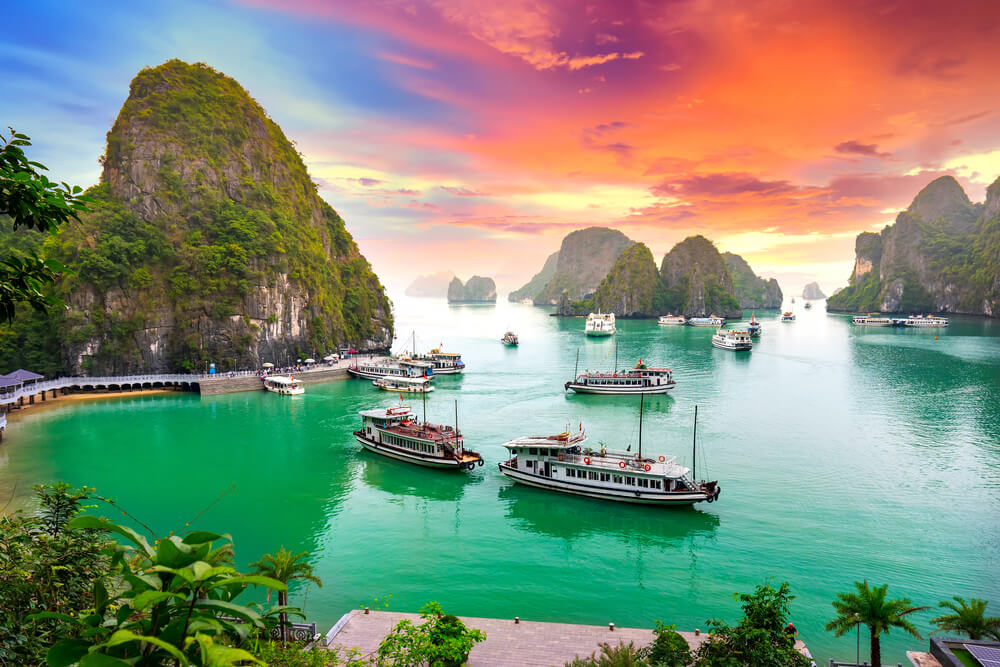
It is clear from the UNESCO World Heritage Sites in Vietnam that the country is full of natural wonders and cultural landmarks.
The question is, when are you planning to go?
FAQ
There are a total of 8.
Citadel of the Ho Dynasty, Complex of Monuments of Huê, Mi-sön Shrine, Central Sector of the Imperial City of Thang Long, Hoi An Old Town, Ha Long Bay, Phong Nha-Ke Bang National Park and Trang An Landscape Complex.
Vietnam is well known for its ancient towns, UNESCO World Heritage Sites, picturesque beaches and rice terraces and, of course, delicious pho!






